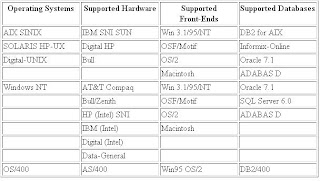Basis is like an operating system for R/3. It sits between the ABAP/4 code and the computer's operating system. SAP likes to call it middleware because it sits in the middle, between ABAP/4 and the operating system.
The predecessor to R/3 is R/2. R/2 is mainframe-based, and SAP ported it to the client/server environment. To do this, SAP created Basis. Creating Basis enabled the existing ABAP/4 code to run on other platforms.
If you refer my earlier post What is R/3 And What Is The Purpose Of R/3 In SAP , you can see Basis sitting between ABAP/4 and the operating system.  ABAP/4 cannot run directly on an operating system. It requires a set of programs (collectively called Basis) to load, interpret, and buffer its input and output.
ABAP/4 cannot run directly on an operating system. It requires a set of programs (collectively called Basis) to load, interpret, and buffer its input and output.
Basis, in some respects, is like the Windows environment. Windows starts up, and while running it provides an environment in which Windows programs can run. Without Windows, programs written for the Windows environment cannot run.
Basis is to ABAP/4 programs as Windows is to Windows programs. Basis provides the runtime environment for ABAP/4 programs. Without Basis, ABAP/4 programs cannot run. When the operator starts up R/3, you can think of him as starting up Basis. Basis is a collection of R/3 system programs that present you with an interface. Using this interface the user can start ABAP/4 programs.
To install Basis, an installer runs the program r3inst at the command-prompt level of the operating system. Like most installs, this creates a directory structure and copies a set of executables into it. These executables taken together as a unit form Basis.
To start up the R/3 system, the operator enters the startsap command. The Basis executables start up and stay running, accepting requests from the user to run ABAP/4 programs.
ABAP/4 programs run within the protective Basis environment; they are not executables that run on the operating system. Instead, Basis reads ABAP/4 code and interprets it into operating system instructions.
ABAP/4 programs do not access operating system functions directly. Instead, they use Basis functions to perform file I/O and display data in windows. This level of isolation from the operating system enables ABAP/4 programs to be ported without modification to any system that supports R/3. This buffering is built right into the ABAP/4 language itself and is actually totally transparent to the programmer.
Platforms and Databases Supported by R/3:
Basis makes ABAP/4 programs portable. The platforms that R/3 can run on are shown in the figure below.
Fig – Table: Platforms and Databases Supported by R/3
For example, if you write an ABAP/4 program on Digital UNIX with an Informix database and an OSF/Motif interface, that same program should run without modification on a Windows NT machine with an Oracle database and a Windows 95 interface. Or, it could run on an AS/400 with a DB2 database using OS/2 as the front-end.
SAP also provides a suite of tools for administering the Basis system. These tools perform tasks such as system performance monitoring, configuration, and system maintenance. To access the Basis administration tools from the main menu, choose the path Tools - Administration.
Basis Administration Tools
Here are some examples of Basis administration tools:
And this is why we call that SAP Basis is designed to run in a client/server configuration.
Sidhika is a computer technology professional, educator with experience in the information technology. She works in a multi-disciplinary role that combines IT Infrastructure, SAP Functional and Network Management. If you like this post, Please leave a comment.



